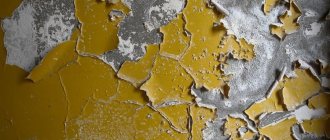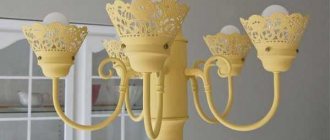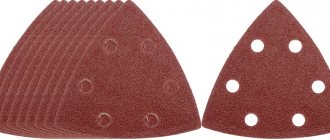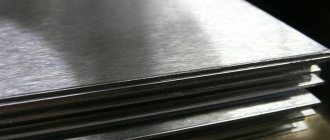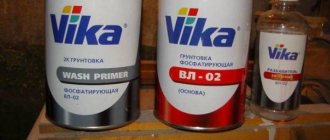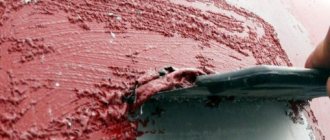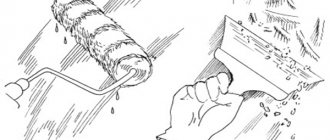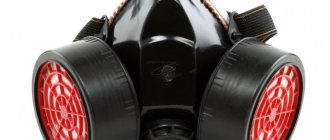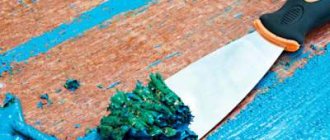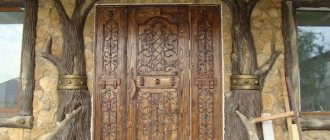Metal doors
It is difficult to imagine any premises in a complete form without installed interior or entrance doors that provide a security barrier, heat retention, and prevent the spread of unwanted sounds. It is worth remembering that in past times and now it is one of the main elements of the design of any interior. Currently, solutions related to filling the room with the spirit of antiquity in retro or country styles have become popular, which involve the use of appropriate design of all elements, including door leaves with fittings, regardless of the material used in their manufacture.
A room with an antique metal door
What you need to know about paint
When deciding to independently design a metal door to look like antique bronze, you need to confidently navigate the method of preparing metal for the procedure, paints, and methods of proper application.
First of all, it is necessary to remember that metal products are dependent on the influence of external factors, the main one of which is moist air, which contributes to the formation of corrosive destruction. Metal paint is primarily intended to prevent such exposure. Secondly, modern paint compositions give the metal surface any color, durable protection, and if antique paint is used with the technique of “aging” the metal, it gives the appearance of almost any material suitable for the interior of a particular room or building.
To paint metal surfaces, paint and varnish mixtures are used, including organic solvents (such as white spirit and the like), as well as synthetic resins. During the drying process, they form protective paint films with characteristics of high density and strength. Such paints are used for processing metal elements in interior spaces, located on the outside of buildings and on streets. In this case, it is necessary to take into account the mode of use of the painted device or element. If this is an antique heating radiator, then the paint should be heat-resistant with high thermal conductivity.
For a long time, blacksmiths tried not to use coloring on their products to preserve the individual characteristics of handmade work. But modern paints, produced by manufacturers specifically for processing such products, make it possible to give the product additional elegance and originality, imitate almost any metal, cause a visual effect of aging, while providing reliable, long-term protection against corrosion. But it should be noted that the cost of such a coating is significant, but the price of forging is comparable.
Antique blacksmith products
What you need for work
The very meaning of the word “patina” has nothing to do with the dyeing process. It is of Italian origin and refers to the film that forms on metal after prolonged interaction with oxygen.
Initially, you had to wait a long time for the metal to oxidize itself, and the result was completely unpredictable; now this technique can be reproduced at home with your own hands using the following materials:
- patina of the color you like (in powder);
- liquid solvent;
- brush (size 2-3) or sponge;
- small plastic or glass trays (do not take metal ones, they can interact with the paint);
- metal product that you want to decorate.
Pay attention to safety precautions! Means for patination involve working with chemical oxidizing agents, solvents and require special care.
It is recommended not to work in confined spaces without respiratory protection. It is better to work in the fresh air, in rooms with good ventilation (with open windows, an exhaust fan on, a draft). If acid gets on the surface of the skin, immediately rinse under running water and then apply a paste of baking soda. If rashes, burns or any skin changes occur, consult a doctor immediately!
Tools and accessories
Carrying out painting work on any surface, including metal, requires the prior acquisition and preparation of the required number of devices and special accessories.
To prepare the surface:
- metal bristle brush,
- sandpaper of various sizes,
- possibly an angle grinder,
- drill with special attachments for cleaning metal,
- if it is necessary to remove old paint - a hair dryer and scrapers,
- rags.
For applying primer paint and varnish coatings:
- paint brushes of various widths, hardness and sizes,
- artistic brushes (if delicate works are required),
- various types of rollers,
- foam elements,
- It is possible to use a painting console.
And:
- Paints and varnishes and solvents.
- Accessories in the form of various containers and more.
Important! Work on painting surfaces and elements should be carried out in a well-ventilated area or outdoors to avoid poisoning from fumes of paints and solvents. At the same time, compliance with fire safety rules must be ensured: exclusion of sources of fire, smoking and the possibility of sparking.
How to select and prepare the necessary composition for painting
Nowadays, using bronze paint is not as labor-intensive as before. Previously, in order to obtain the required composition, bronze powder had to be thoroughly mixed in an organic solvent. Now special acrylic pigments are introduced into the composition of bronze paint, which are easily soluble even with water.
The presence of an acrylic component allows you to get rid of another drawback of the previous bronze paint - its electrical conductivity, which limited the use of the composition when painting some metal surfaces. Finally, replacing the solvent with acrylic also eliminated the unpleasant odors that inevitably accompanied painting. Therefore, the choice of bronze paint can be made from two main options:
- acrylic paint, which is applied to the surface using traditional painting supplies;
- bronze paint in cans, the aerosol of which will perform the coating using conventional spraying.
Each method has its own rational areas of application. For example, to paint surfaces with complex configurations or to renovate certain areas of antique interior items, painting with a brush is more suitable. Aerosol is more profitable if you want to get a bronze coating on a flat surface.
Method of painting metal surfaces bronze
Painting metal surfaces bronze has been used for decades, but due to the unpleasant odor and poor resistance to temperature conditions, the possibility of use was limited. Modern paint mixtures based on acrylic and water have expanded the scope of application. They are characterized by resistance to operating temperature conditions, exceptional resistance to corrosion, and do not create discomfort when painting room elements.
Door elements in an old bronze look
Important! Any work related to the processing of metal products is associated with the possible formation of chips, which can harm human skin. At the same time, contact with exposed areas of the body by chemical compounds, including paints and varnishes, can lead to burns. Thus, when carrying out the work listed below, it is mandatory to use protective clothing, headgear and goggles.
Currently, the following procedure is used when painting bronze:
- Applies to all types of surface painting. It is necessary to prepare surfaces for painting by removing old paint, rust, etc. using suitable equipment.
- Mandatory degreasing is carried out.
- To improve the quality of adhesion and create additional anti-corrosion protection for the material, the surface is primed.
- After drying, apply a layer of bronze paint. After drying, the procedure is repeated until the desired visual effect.
Preparing the surface for paint
How to paint metal like old bronze
Light antique painting is a fairly popular operation when creating various interiors.
It is traditionally believed that antique items add an element of sophistication and luxury, emphasizing the style and wealth of the owner of the room. However, genuine antiques are highly expensive and often require restoration and special care. It is much easier to simulate the aging of an object. And today this art is mastered not only by artists, but also by painters and simply amateurs. So, it will be quite possible for you to paint antique furniture if you set yourself such a task. But before you tackle your great-grandmother's chest of drawers, practice on something less valuable.
Methods for aging wood and other materials
There are several ways to age furniture and other types of materials:
- application of special compounds that change the appearance and properties of the top layer of coating (available for wood and metal work);
- painting with several paints of different colors so that the lower layers show through the upper ones;
- processing with sandpaper and other abrasive materials;
- the use of pigments that create the illusion of aging and some dirt.
Painting wooden elements
The most ordinary things can be turned into decorative furniture or accessories that are not inferior to antique items in terms of sophistication and the ability to create a special atmosphere in the room.
The question of how to paint antique wood arises when you want to make original and sophisticated-looking details using existing interior elements.
Antique painting of wood is quite possible at home; all you need is the most common tools. Before painting, it is necessary to carry out preliminary preparation of the object to be decorated.
Before aging a product, several stages of work are carried out:
- The surface of the object being processed is cleaned. Varnish, old paint, and any other coating are removed from wood. Those parts and fittings that are not planned to be painted are dismantled.
- The surface is polished and then cleaned from dirt and dust.
- The surface is primed with antiseptic compounds to avoid subsequent rotting or mold damage. The primer will also ensure the paint adheres better.
It is not recommended to use putty when preparing to age wood. With this design solution, the emphasis is on the presence of small defects in the wood, so you should not completely mask the flaws.
Creating the effect of dilapidation and wear
Artificially giving wood a shabby and dilapidated look is called brushing. The production uses sandblasting, during which soft fibers are removed from the top layer, causing the structure of the wood to become more pronounced.
When processing antique wood in a similar way with your own hands, the surface is first covered with matte acrylic paint. After it dries, abrasions are formed using a metal sponge or sandpaper, while individual areas can be affected more intensely to obtain a more natural look. The product is cleaned and a second coat of paint is applied.
At the end of the processing, it makes sense to go over the wood with a fine-grained abrasive tool.
Without using paint, you can achieve the effect of antiquity by painting wood with stain. This special material stains the wood by penetrating into its outer layer.
During absorption, the stain colors the wood in its natural color, while emphasizing the texture. There are also colorless compositions that perform exclusively protective functions.
The stain is applied with a cotton-gauze swab - a piece of cotton wool is wrapped in folded gauze. The composition is poured into the cotton wool so that it saturates it, but does not leak out when you press the tampon. Then the stain is rubbed over the entire surface. The process is repeated several times.
Sandpaper creates abrasions on the treated surface. The result is a natural wooden plane with pronounced texture and wear, characteristic of antique interior items.
Using a special varnish coating
To create a surface cracked by time, craquelure compositions are used, forming a coating on the product with a characteristic pattern in the form of uneven violations of the integrity of the paint layer.
This technique is called crackle; the “aging” of the product is carried out as follows:
- The product is cleaned and the surface is covered with a layer of paint. Please note that cracks in the final coating will have the same color as the first coat of paint.
- The dried paint is covered with craquelure varnish, which must be applied in one direction. A transparent film will appear on the surface.
- A base layer of paint of the desired color is applied over the craquelure varnish. This layer cracks under the influence of the craquelure composition, and the entire surface takes on a characteristic appearance with small cracks.
- To protect the aged surface, it should be coated with a transparent varnish.
Patina coating
To imitate the oxidation process characteristic of products made from certain metals, patina paint is used. This creates a rather interesting and unusual image of wood with the effect of antiquity and the color of bronze.
In order for a wooden object to acquire a specific antique look, its surface is first varnished to increase strength and wear resistance. When the varnish is dry, a thin layer of patina paint is applied to the surface.
After 30–40 minutes, the treatment is carried out with an abrasive tool, sandpaper or metal sponge. The effect increases with increasing intensity of such treatment.
Using a cloth, the resulting dust is removed, and the product is treated with transparent varnish.
Painting in several layers
With the help of multi-layer coloring, the effect of an aged object, which was previously often repainted, is achieved. This antique painting of furniture is based on the factorial characteristics of wood and color differences.
The selected primary color is applied to the surface. This layer should be thin, so that the wood pattern is clearly visible. An abrasive tool creates abrasions and the product is painted with a second color. This layer is applied with light, careless strokes.
For additional realism of the color, in some places the second layer of paint is shaded so that the main background appears.
Aging of metal
New metal parts do not always fit into a sophisticated and thoughtful interior, primarily due to the presence of a characteristic shine. The use of antique metal objects is not available to everyone, so it is more advisable to artificially create the effect of antiquity using imitation paints or special surface treatment.
You can paint antique metal with your own hands sequentially as follows:
- The surface of the product is degreased and treated with a primer to improve the quality of subsequent painting.
- After the primer has dried, the product is painted over with metallic paint.
- When the paint is completely dry, it is evenly treated with a craquelure primer, which forms a transparent polymer film during the fixing process.
- The surface treated with this primer is covered with a craquelure composition, which adds characteristic cracks and gives the metal product the appearance of an antique item slightly touched by corrosion.
In addition, to give metal an antique effect when painting, you can use various pigmenting compounds. For these purposes, umber is often used, a mineral pigment that is resistant to light and alkalis.
Burnt umber is applied in a small amount to a piece of fabric and rubbed into the painted surface. The pigment remaining in the cracks of the coating completes the look of the antique item.
Painting brick walls
Brick itself often has a rather retrograde look, so painting such antique walls seems to be the simplest and is done by covering it with acrylic paints in the desired colors. Antique brick painting differs from conventional painting by a special method of applying acrylic.
Antique bronze coating of metal
To give the product the appearance of an antique item, it is necessary to carry out the following sequence of procedures:
- Preparation of the product for painting remains unchanged.
- We apply the painting technique described earlier.
- Natural irregularities with depressions must be treated with patina to the required percentage of darkening.
- After drying, use a brush to glaze the corners with light paint, creating the effect of wear and tear from aging.
- Finish by applying a thin layer of varnish.
Bronze with an aging effect
To obtain the effect of old bronze, a technique using a craquelure primer coating is often used, which as a result gives the product a look with traces of rust, which ultimately represents the illusion of an old material.
Craquelure primer effect
Features of working with chrome-plated parts
During preparatory work and during the painting process, difficulties may arise with removing chrome, which is best rubbed with a special machine. Manual work will require diligence and a large supply of free time.
If you decide to transform the appearance of your car yourself and replace boring chrome parts with beautiful coal-black ones, then you should be patient and use high-quality materials. This process is quite lengthy, especially if you have to remove chrome from plastic yourself, but by following our recommendations, you will be able to do this job efficiently, and the effect will last a long time.
Design errors
Unfortunately, it is not uncommon for a product to have a significant amount of time and money spent on aging, but it has an unfinished, and often contradictory, look to the era of imitation. The reasons include poor training of the person who carried out this work, violation of recommendations on the methodology and sequence of work, and may only consist of a careless attitude to detail. For example, painstaking work was carried out and the metal doors were painted in an antique style, but the frame did not undergo any changes, the fittings and small door parts have a modern design. The overall picture is not original, but rather unpleasant. If we consider the issue more deeply, then it is important to involve several elements of the overall interior of the room in the architectural group to create the effect of an ancient component.
A variant of the technique for making an antique door leaf is demonstrated in the following video.
Making an antique metal door.
Voted over 229 times, average rating 4.4
Comments
Alexander 09/11/202015:25 I wonder if this was written by a normal person? The main thing is that he did not answer the main question. Uncle!!! What kind of paint???
Grade
Sergey 09.25.202003:39 Hello, there is an error on your site. Avast antivirus prevents you from accessing your website. Please take action.
Grade
Add a comment Cancel reply
We recommend reading
Metal doors Preparatory work and installation of vestibule doors on the landing Today, vestibule doors with intercom are popular among ...
Metal doors The feasibility of installing stainless doors with glass and the scope of application Stainless steel is considered an ideal material for the manufacture of ...
Metal doors SNiP requirements: installation of a metal door in a room The production of steel doors is regulated by a special regulation, ...
Metal doors What is needed to remove whitewash from an iron door When renovating a house or entryway, it is not always possible to protect...
Types of dye and their advantages
Previously, bronze paint contained organic solvents.
This resulted in a strong odor coming from the paint. Nowadays, instead of outdated compositions, mixtures are used for coloring metals. They are water soluble and contain only natural ingredients. Modern dyes now contain metallic pigments of natural origin. They use acrylic dyes as binding elements.
Painting metals bronze has the following advantages:
- Environmentally friendly and odorless.
- Low price, which is explained by the water-based paint composition for metal.
- Possibility of obtaining various natural stylizations (for example, antique).
- Ease of processing products.
- Reliable protection of metal surfaces from moisture and corrosion.
- The service life of surfaces painted with this composition is tens of years.
If the surface is pre-painted with a layer of electrically conductive paint, its corrosion protection is simplified due to the formation of a galvanized film.
Also, the advantages of bronze dye include high resistance of the coating to UV radiation and external mechanical influences.
